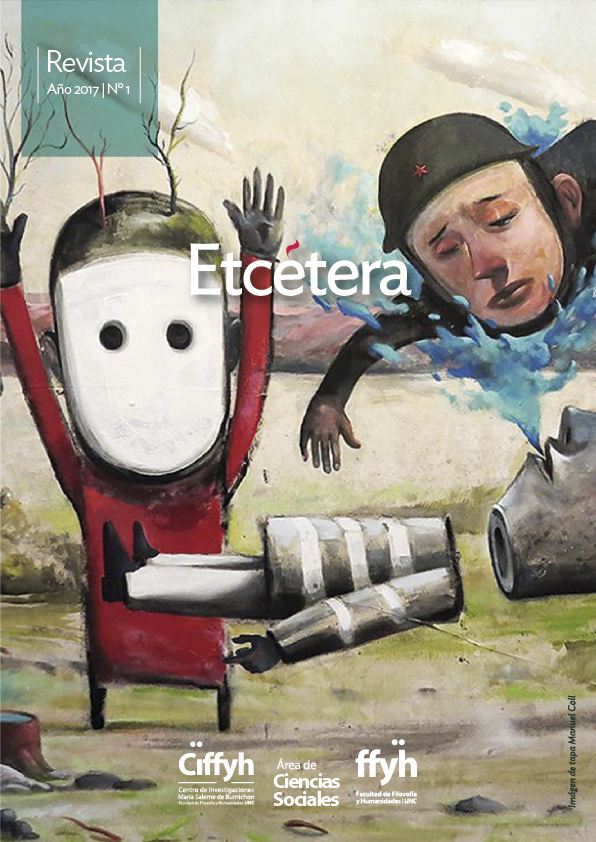Introduciendo escenas musicales (Traducción)
Palabras clave:
escenas musicales, industria musical, comunicaciónResumen
El texto pertenece a la introducción del libro “Music scenes: local, translocal and virtual”, publicado en el año 2004 por Vanderbilt University Press. El mismo fue traducido para el Seminario optativo “Mundos, escenas y géneros musicales: Aproximaciones teórico-metodológicas”, desarrollado en el año 2017 para la carrera de Licenciatura en Antropología de la Facultad de Filosofía y Humanidades de la Universidad Nacional de Córdoba. El seminario fue dictado en el marco de inquietudes teórico-metodológicas propuestas por el equipo docente dirigido por el Dr. Gustavo Blázquez e integrado por Mgstr. Fabiola Heredia, Lic. María Sol Bruno, Mgstr. Cecilia Castro, Lic. Marta Gastañaga Lacunza, Dra. María Inés Landa, Lic. Leticia Le Bihan, Lic. Agustín Liarte Tiloca, Lic. Florencia López, Lic. María Eugenia Mackinson, Lic. Ana Laura Reches, Daniela Brollo, María Esteve y Rocío Rodríguez. La publicación de esta traducción fue autorizada por la dirección de la editorial Vanderbilt University Press, con la anuncia de Andy Bennett.
Descargas
Referencias
Becker, H. (1951). “The professional dance musician and his audience”. En: American Journal of Sociology, Nº 57, pp. 136.44. Estados Unidos: University of Chicago Press.
Becker, H. (1963). Outsiders: studies in the sociology of deviance. New York: Collier Macmillan.
Becker, H. (1976). “Art worlds and social types”. En: Peterson, R. (ed.), The production of culture. Beverly Hills: SAGE Journals.
Becker, H. (1982). Art worlds. Berkeley: University of California Press.
Bennett, A. (1999). “Subcultures or neo-tribes? Rethinking the relationship between youth, style, and musical taste”. En: Sociology, Nº 333, pp. 599-617. Inglaterra: British Sociological Association.
Bennett, A. (2000). Popular music and youth culture: music, identity, and place. Londres: Macmillan.
Bjurström, E. (1997). “The struggle for ethnicity: Swedish youth styles and the construction of ethnic identities”. En: Young: Nordic Journal of Youth Research, Nº 5, pp. 44-58.
Bourdieu, P. (1984). Distinction: a social critique of the judgement of taste. Londres: Routledge and Kegan Paul.
Chaney, D. (1996). Lifestyles. Londres: Routledge.
Clarke, G. (1990). “Defending ski-Jumpers: a critique of theories of youth subcultures”. En: Firth, S., y Goodwin, A. (eds.), On record: rock, pop, and the written word. Londres: Routledge.
Cohen, S. (1991). Rock culture in Liverpool: popular music in the making. Oxford: Clarendon Press.
Condry, I. (1999). “The social production of difference: imitation and authenticity in Japanese rap music”. En: Fehrenbach, H., y Poiger, U. (eds.), Transactions, transgressions, transformations: American culture in Western Europe and Japan. Providence: Berghan Books.
Denisoff, S., Peterson, R. (eds.). (1972). The sounds of social change. Chicago: Rand-McNally.
DeVeaux, S. (1997). The birth of BeBop: a social and musical history. Berkeley: University of California Press.
Duncombe, S. (1997). Notes from underground: zines and the politics of alternative culture. London: Verso.
Forman, M. (2002). The hood comes first: race, space, and place in rap and hip-hop. Hanover: Wesleyan University Press.
Frith, S. (1983). Sound effects: youth, leisure, and the politics of rock. Londres: Constable.
Frith, S. (1996). Performing rites: on the value of popular music. Cambridge: Harvard University Press.
Gaines, D. (1994). “The local economy of suburban scenes”. En: Epstein, J. (ed.), Adolescents and their music: if it’s too loud, you’re too old. New York: Garland.
Gebesmair, A., y Smudits, A. (eds.). (2001). Global repertories: popular music within and beyond the transnational music industry. Aldershot: Ashgate.
Gelder, K., y Thornton, S. (eds.). (1997). The subcultures reader. Londres: Routledge.
Gilroy, P. (1993). The Black Atlantic: modernity and double consciousness. Londres: Verso.
Harris, K. (2000). “‘Roots?’ The relationship between the global and the local within the extreme metal scene”. En: Popular Music, Nº 191, pp. 13-30. Cambridge University Press.
Hemment, D. (1998). “Dangerous dancing and disco riots: the Northern Warehouse Parties”. En: McKay, G. (ed.), DIY culture: party and protest in Nineties Britain. Londres: Verso.
Jarviluoma, H. (2000). “From Manchuria to the traditional village: on the construction of place via Pelimanni Music”. En: Popular Music, Nº 191, pp. 101-124. Cambridge University Press.
Kibby, M. (2000). “Home on the page: a virtual place of music community”. En: Popular Music, Nº 191, pp. 91-100. Cambridge University Press.
Kruse, H. (1993). “Subcultural identity in alternative music culture”. En: Popular Music, Nº 121, pp. 31-43. Cambridge University Press.
Laing, D. (1985). One chord wonders: power and meaning in punk rock. U.K: Open University Press.
Laing, D. (1997). “Rock anxieties and new music networks”. En: McRobbie, A. (ed.), Back to reality: social experience and cultural studies. U.K: Manchester University Press.
Lee, S. (1995). “Re-examining the concept of the ‘independent’ record company: the case of Wax Trax! Records”. En: Popular Music, Nº 141, pp. 13-32. Cambridge University Press.
Lena, J. (2003). From ‘flash’ to ‘cash’: producing rap authenticity, 1979 to 1995. Disertación doctoral. Columbia University.
Lipsitz, G. (1994). Dangerous crossroads: popular music, postmodernism, and the poetics of place. Londres: Verso.
McRobbie, A., y Garber, J. (1976). “Girls and subcultures: an exploration”. En: Hall, S., y Jefferson, T. (eds.), Resistance through rituals: youth subcultures in Post-War Britain. Londres: Hutchinson.
Mitchell, T. (1996). Popular music and local identity: rock, pop, and rap in Europe and Oceania. Londres: Leicester University Press.
Negus, K. (1992). Producing pop: culture and conflict in the popular music industry. Londres: Edward Arnold.
Negus, K. (1999). Music genres and corporate cultures. Londres: Routledge.
Olson, T. (1999). “Hippie hootenanny: Gram Parsons and the Not-Quite-Nashville Cats”. En: Journal of Country Music, Nº 203, pp. 26-36. Nashville: The Country Music Foundation.
Peterson, R. (1973). “The unnatural history of rock festivals: an instance of media facilitation”. En: Popular Music and Society, Nº 2, pp. 1-26. UK: Taylor & Francis.
Peterson, R. (1978). “Disco! Its distinctive sound isn’t just another fad”. En: Chronicle of Higher Education, Nº 2, pp. 26-27. Washington.
Peterson, R. (1990). “Why 1955? Explaining the advent of rock music”. En: Popular Music, Nº 9, pp. 97-116. Cambridge University Press.
Peterson, R. (1994). “Culture studies through the production perspective: progress and prospects”. En: Crane, D. (ed.), The sociology of culture. Oxford: Blackwell.
Peterson, R. (1997). Creating country music: fabricating authenticity. Chicago: University of Chicago Press.
Redhead, S. (ed.). (1993). Rave off: politics and deviance in contemporary youth culture. U.K: Avebury.
Rose, T. (1994). Black noise: rap music and black culture in contemporary America. Hanover: Wesleyan University Press.
Ryan, J., y Peterson, R. (1994). “Occupational and organizational consequences of the digital revolution in music making”. En: Cantor, M., y Zollars, S. (eds.), Creators of culture. Greenwich: JAI Press.
Shank, B. (1994). Dissonant identities: the rock ’n’ roll scene in Austin, Texas. Londres: Wesleyan University Press.
Slobin, M. (1993). Subcultural sounds: micromusics of the West. Londres: Wesleyan University Press.
Smith, R., y Maughan, T. (1997). Youth culture and the making of the post-fordist economy: dance music in contemporary Britain. Londres: Department of Social Policy and Social Science, Royal Holloway, University of London.
Straw, W. (1991). “Systems of articulation, logics of change: communities and scenes in popular music”. En: Cultural Studies, Nº 53, pp. 368-388. UK: Taylor & Francis.
Thornton, S. (1995). Club cultures: music, media, and subcultural capital. Cambridge: Polity Press.
Urry, J. (1990). The tourist gaze: leisure and travel in contemporary societies. Londres: Sage.
Wellman, B., y Gulia, M. (1999). “Virtual communities as communities”. En: Smith, M., y Kollock, P. (eds.), Communities in cyberspace. Londres: Routledge.
Williams, R. (1965). The long revolution. Londres: Pelican.
Descargas
Publicado
Número
Sección
Licencia
Aquellos autores/as que tengan publicaciones con esta revista, aceptan los términos siguientes:
- Los autores/as conservarán sus derechos de autor y garantizarán a la revista el derecho de primera publicación de su obra, el cuál estará simultáneamente sujeto a la Licencia de reconocimiento de Creative Commons que permite compartir, copiar, distribuir, ejecutar y comunicar públicamente la obra, siempre que: 1) se cite la autoría y la fuente original de su publicación (revista, editorial y URL de la obra); 2) no se use para fines comerciales; 3) En caso que se transforme o genere una obra derivada a partir de esta obra, deberá compartise bajo las mismas condiciones establecidas por esta licencia.
- Los autores/as podrán adoptar otros acuerdos de licencia no exclusiva de distribución de la versión de la obra publicada (p. ej.: depositarla en un archivo telemático institucional o publicarla en un volumen monográfico) siempre que se indique la publicación inicial en esta revista.
- Se permite y recomienda a los autores/as difundir su obra a través de Internet (p. ej.: en archivos telemáticos institucionales o en su página web) luego de la publicacion del articulo, lo cual puede producir intercambios interesantes y aumentar las citas de la obra publicada. (Véase El efecto del acceso abierto).
- El titular del copyright es Etcétera. Revista del Área de Ciencias Sociales del CIFFyH.



















